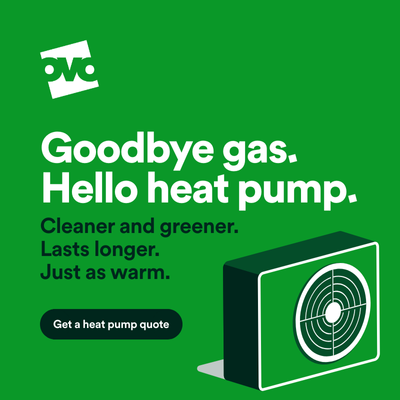Seal the Deal: Don't Let Your Heat Pump Leak Energy
In recent years, one critical aspect of air source heat pump installations has often been neglected: external pipe insulation. As the demand for energy efficiency increases, the importance of using the best possible external insulation for ASHPs cannot be overstated. So let's delve into why high-quality external insulation is essential and what characteristics make insulation effective and reliable.
Water Resistance
Moisture can drastically reduce the thermal efficiency of insulation. When insulation becomes wet, its thermal conductivity increases, leading to energy loss and the deterioration of the material. Therefore, insulation with high water diffusion resistance is crucial. Additionally, sealing all joints and gaps is essential to prevent water ingress through capillary action. If the insulation is not protected and every joint and gap is not sealed correctly, efficiency is seriously compromised.
Optimal Insulation Efficiency
The primary function of insulation is to minimise thermal loss. This requires materials that fit well without being compressed, as squeezing insulation into tight spaces can reduce its effectiveness and cause thermal bridging. Ensuring that the insulation is properly clipped on the outside and sealed around pipes and fixtures is vital to maintaining efficiency and preventing moisture penetration. The issue is exacerbated when using standard plastic trunking designed for smaller air conditioning pipework. For instance, the typical 140mm trunking hides multiple issues because the two insulated pipes have to be squeezed in to fit, reducing insulation efficiency and potentially causing thermal crossover that can affect the heat pump’s operation.

What's more, installers using thinner wall thicknesses than the 19mm standard compromise insulation further. Since it is impossible to clip on the outside of the insulation correctly, many installers resort to clipping the pipework first and then insulating it, using tie wraps to hold the insulation together around the clips. This method leaves gaps and makes it difficult to ensure a consistent seal, reducing the system’s overall efficiency.
UV Protection and Air Contamination Resistance
External materials are subject to degradation from UV rays. Insulation must have built-in UV protection to withstand outdoor conditions over time. Furthermore, in areas with air pollution, such as near factories or busy roads, insulation needs additional protection to prevent contamination that can impair its function. This level of protection should be present out of the box, as adding UV protection during installation in varying weather conditions is impractical and often ineffective.
Through-Wall Sleeving
When pipes pass through walls, sleeving protects the insulation from damage and prevents pests from compromising the system. Proper sleeving and sealing ensure that the integrity of the insulation is maintained, thereby preserving the overall energy efficiency of the building. Standard shrouds on plastic trunking are often not large enough to cover two separate insulated pipes, leading many installers to use a 4-inch core and soil pipe. This approach is problematic as it is not waterproof, allowing moisture to enter through joints and gaps, creating a microenvironment that can never dry out, further degrading the insulation.
All-Weather Installation Capability
Professional installers often work in varied weather conditions. Therefore, insulation products must be easy to install regardless of the weather. This requirement ensures that installations are not delayed and that the insulation performs as expected in both extreme heat and cold. Products must be designed for general weather conditions to help the professional installer complete the job efficiently and effectively.
Sealing of Joints and Gaps
To maintain efficiency, all joints and gaps must be meticulously sealed. Proper sealing prevents thermal leaks and moisture ingress, which can undermine the insulation’s performance and longevity. The insulation products need to support easy sealing, ensuring that every joint and gap is closed, including those through the wall. If plastic trunking large enough to house the insulation correctly were available, it would need to feature high water resistance, be sealed on all joints, and clipped externally.

Ease of Maintenance
Regular maintenance is essential for sustaining the efficiency of ASHPs. This includes inspecting and maintaining external insulation and ensuring that all joints remain sealed. High-quality insulation products should facilitate easy maintenance, helping to ensure long-term performance and reliability. Annual services on heat pumps and systems must include checking the external insulation and all joints to maintain and protect the system’s efficiency and all external products.
Closing Thoughts
Investing in high-quality external insulation for air source heat pumps is crucial for maximising energy efficiency and protecting the system from environmental factors. By ensuring that the insulation is water-resistant, UV-protected, easy to install in all weather conditions, and properly sealed, professionals can significantly enhance the performance and lifespan of ASHP installations. Regular maintenance further ensures that the insulation continues to function optimally, providing consistent energy savings and durability.
This article was written and provided by Primary Pro. Their bespoke insulation solutions not only maximise heat pump efficiency but also enhance the aesthetic appeal of your customers’ homes, guaranteeing a high-quality finish designed to meet the unique needs of professional installers. Primary Pro offer a comprehensive range of insulation products and tools, from various insulation sizes to innovative sealing solutions, all designed to make installations smoother and more efficient. For more information, visit their website or contact them at info@primarypro.co.uk.
Thank you @david-s and @editor. This is just how an "infomercial" should be; heavy on the info and clear about the vested interest for the contributor.
Good article.
105 m2 bungalow in South East England
Mitsubishi Ecodan 8.5 kW air source heat pump
18 x 360W solar panels
1 x 6 kW GroWatt battery and SPH5000 inverter
1 x Myenergi Zappi
1 x VW ID3
Raised beds for home-grown veg and chickens for eggs
"Semper in excretia; sumus solum profundum variat"
external pipe insulationPosted by: @david-s
Just need to maths to backup the facts stated. Optimization of the insulation thickness for different climates and flow temperature would be good. Otherwise worthless advertising.
Posted by: @Anonymous
Otherwise worthless advertising.
’Fraid I can’t agree, @johnmo.
What the article says may seem really obvious but we only need to look at the many many examples of badly finished installs to see that basics like this just aren’t front dead centre of many customers’ minds. In many ways if there’s some lagging on the pipes then “the installer must have done a thorough job, mustn’t they?”
To my mind the article is simply laying out some reasonable standards that can save a significant amount of money year on year. We often get caught up in technical rabbit holes for improving performance but the basics deserve an airing too from time to time.
105 m2 bungalow in South East England
Mitsubishi Ecodan 8.5 kW air source heat pump
18 x 360W solar panels
1 x 6 kW GroWatt battery and SPH5000 inverter
1 x Myenergi Zappi
1 x VW ID3
Raised beds for home-grown veg and chickens for eggs
"Semper in excretia; sumus solum profundum variat"
@majordennisbloodnok bang on. That was the motivation behind the article, because external insulation is often neglected and forgotten about, especially on short outside runs to the house. This is just a reminder to homeowners to raise this with their installers. Dave was kind enough to write this piece, which is not a paid or sponsored link – I just thought it would be something helpful and interesting for homeowners.
Get a copy of The Ultimate Guide to Heat Pumps
Subscribe and follow our YouTube channel!
@johnmo Primary Pro have a tonne of literature. I'll ask @david-s if they have a document that provides some of this info.
Get a copy of The Ultimate Guide to Heat Pumps
Subscribe and follow our YouTube channel!
Shocking indeed, except possibly the second one. Are you certain this isn't a pair of anti - freeze valves?
4kW peak of solar PV since 2011; EV and a 1930s house which has been partially renovated to improve its efficiency. 7kW Vaillant heat pump.
Posted by: @barbie1
What parts of the air source heat pump should I be insulating?
None
You insulate the piping, valves (not anti freeze valves) between the house and the ASHP. So from the outlet connections on the ASHP to and through the house wall.
Posted by: @AnonymousPosted by: @barbie1What parts of the air source heat pump should I be insulating?
None
You insulate the piping, valves (not anti freeze valves) between the house and the ASHP. So from the outlet connections on the ASHP to and through the house wall.
Don't forget the pipework inside also needs to be insulated.
There is a school of thought, that says not to bother if the pipes are inside the heated environment, especially if you are running low and slow on a single zone. See Heat Geek for more information.
- 26 Forums
- 2,342 Topics
- 53 K Posts
- 203 Online
- 6,000 Members
Join Us!
Worth Watching
Latest Posts
-

RE: Are We Sleepwalking Into Another Race to the Bottom?
…otherwise known as “hive got news for you”. And don’...
By Majordennisbloodnok , 2 hours ago
-
RE: Configuring third party dongle for Ecodan local control
Logically, I'll fall into that category so the natural ...
By Sheriff Fatman , 2 hours ago
-

RE: Controlling Daikin Altherma via P1P2 and Home Assistant
I haven’t got a Daikin but I have been having some fun ...
By Majordennisbloodnok , 3 hours ago
-

RE: Setback savings - fact or fiction?
@robs — thanks again for your detailed comments. Some r...
By cathodeRay , 5 hours ago
-
RE: Free Ecoheat Heat Pump Install
I don't mind thread drift, it's how conversation natura...
By Deltona , 7 hours ago
-

RE: A Smarter Smart Controller from Homely?
@papahuhu I hope you get a swift resolution. Regards, T...
By Toodles , 9 hours ago
-

RE: Poll for Time of Use, tariffs, technology
That’s fine by me too Major, I feel it is a sad reflect...
By Toodles , 10 hours ago
-

Bingo. Sometimes a judiciously placed size 10 bovver bo...
By Majordennisbloodnok , 11 hours ago
-
RE: Mitsubishi Ecodan 11.2kW heat pump with low COP
@ciocoiu-alexandru I can't provide the same level of di...
By Sheriff Fatman , 11 hours ago
-
RE: Octopus Cosy Heat Pump Owners & Discussion Thread
Recently had my follow up with octopus for the vibratio...
By swwils , 12 hours ago
-

The three technical issues I'm considering are: BMS...
By Transparent , 13 hours ago
-
RE: LiFePO4 lithium battery fires and explosions
@transparent Your post may fit better in th...
By Batpred , 13 hours ago
-

RE: British Gas vs Octopus Energy vs Heat Geek vs EDF vs Aira vs OVO vs EON.Next vs Boxt
@jamespawhite, if you could be bothered, you could also...
By Mars , 15 hours ago
-
RE: Commencing on an ASHP Installation Process
I've got a bit of time to draft something today, so the...
By Sheriff Fatman , 1 day ago
-
RE: Help with heat pump sizing
@amin I dont think materially relative to t...
By JamesPa , 1 day ago
-

@majordennisbloodnok I have decided to take the plunge....
By TechnoGeek , 1 day ago
-
RE: Different dT on each radiator?
I cant sorry. Its based on some calculations I did fro...
By JamesPa , 2 days ago
-
RE: Help me keep the faith with my air source heat pump installation
@simonf thats interesting as I’ve noticed my flow and r...
By AdamK , 3 days ago















